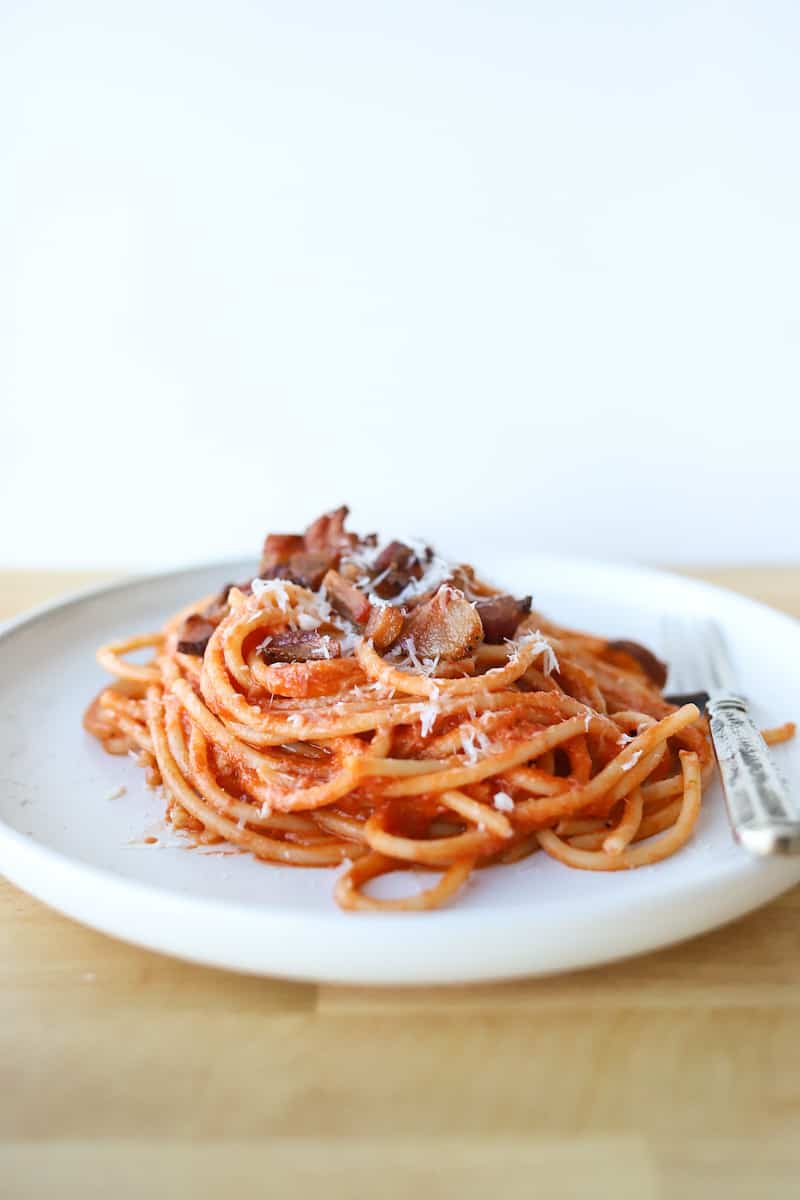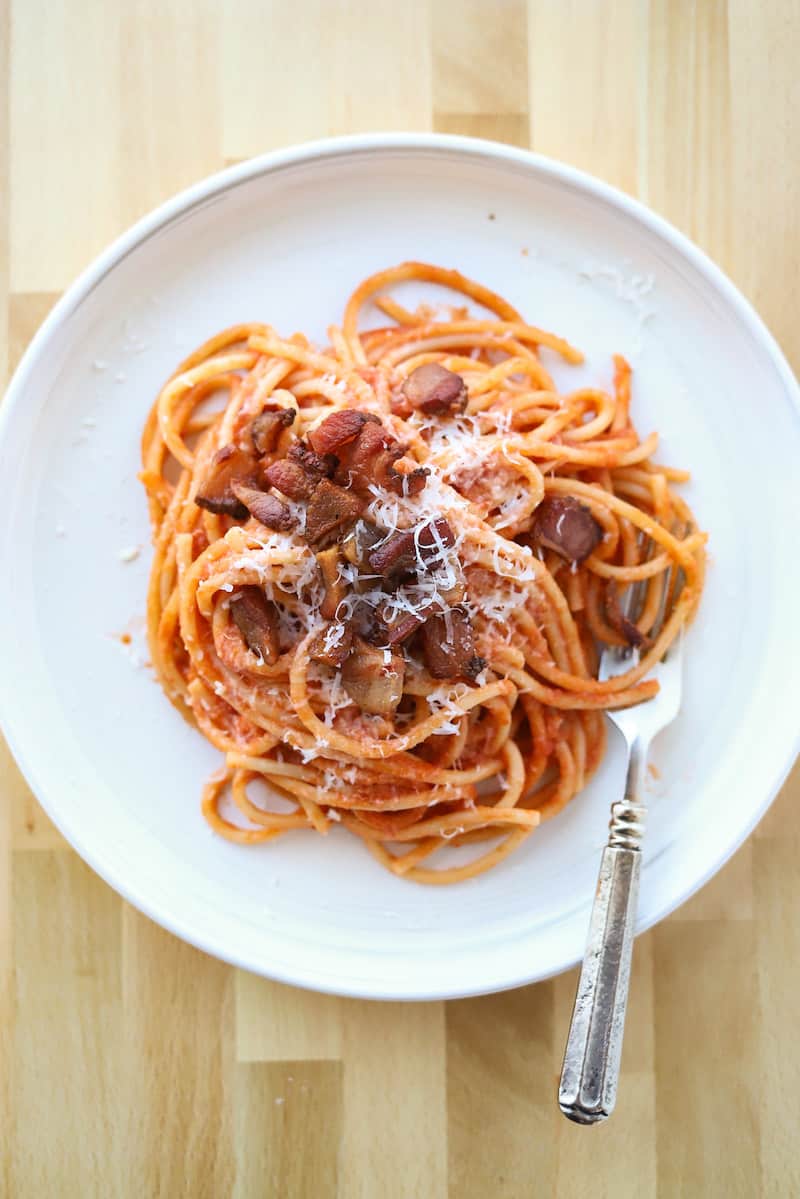There are four main authentic pasta dishes in Rome including Cacio e Pepe, Gricia, Carbonara, and Amatriciana. Each dish is distinctively different, and each is fantastically delicious, but one of the best of this bunch is no doubt the Amatriciana. Commonly served with Bucatini, this dish is known to many as Bucatini all’Amatriciana.

This recipe is inspired by the Bucatini all’Amatriciana from Trattoria Da Cesare al Casaletto in Rome– the absolute best place to enjoy this iconic dish in the Eternal City. Other favorite restaurants for this dish also include SantoPalato (made with rigatoni) and Roscioli (also prepared with rigatoni).
RELATED: 20 BEST RESTAURANTS IN ROME
How to pronounce Bucatini all’Amatriciana
You’re going to need to know how to pronounce the name of your new favorite pasta dish when you tell your friends and family, so let’s practice. Bucatini = boo-kuh-tee-nee. Amatriciana = aa-muh (rhymes with comma)-tree-cha-nuh.
What is Bucatini all’Amatriciana?
In essence, Amatriciana (the “sauce” and all of the amazing flavor for this dish) is made with olive oil, tomatoes, guanciale (pork cheek), Pecorino Romano, and shallots (or in some cases onion and garlic). Like many other beloved Italian dishes, it’s fairly minimalist and packed full of flavor. Amatriciana is most traditionally served with Bucatini, which is really close to spaghetti except this pasta is hollow on the inside, which allows more of that dreamy Amatriciana sauce to get trapped inside. Many fantastic restaurants in Rome serve it with Rigatoni. You can use whatever pasta you like for this recipe, just make sure the weight is the same (12 ounces).

Recipe Ingredients
- extra virgin olive oil
- guanciale
- shallots
- San Marzano tomatoes
- red pepper flakes
- kosher salt and fresh cracked pepper
- bucatini or other pasta
- Pecorino Romano
How to Make Bucatini all’Amatriciana
Making Bucatini all’Amatriciana is one of the less complicated pasta dishes you will make in your life. Once your ingredients are assembled simply cook the chopped guanciale in some olive oil and set aside (keep the rendered fat from the guanciale– you’re going to want those amazing flavors in your sauce). You’ll next cook your shallots and tomatoes in the remaining oil/fat, then add seasonings, Pecorino Romano, a splash of pasta water and finally your beloved bucatini. Serve it hot with copious amounts of additional Pecorino and your crispy, heavenly guanciale sprinkled on top.
Why we love this recipe
It’s a lofty claim, but this Bucatini all’Amatriciana recipe is absolutely perfect. First and foremost, the flavors of the Amatriciana are authentic and laced with flavor. Because you’re cooking with a few high-quality ingredients, including San Marzano tomatoes, guanciale (totally different from other cuts of pork like pancetta or bacon), and olive oil, it’s a foolproof recipe for success. Secondly, we swear by our method for cooking and serving the guanciale. Crisping it up in olive oil not only will help develop the amazing flavors of your Amatriciana, but will also give the guanciale the perfect crispy texture. Furthermore, we don’t toss the guanciale with the tomato sauce or cook with any other ingredients, but rather serve it on top of the pasta dish, so it can be enjoyed in its perfectly, unadulterated state as it should be. Thirdly, this Bucatini all’Amatrician recipe highly encourages each dish to be served not only with crispy guanciale on top, but with a generous amount of Pecorino Romano, just as it’s served in Rome. Because there’s no such thing as too much Pecorino!
Bucatini all’Amatriciana
Ingredients
- 2 Tablespoons extra virgin olive oil
- 6 ounces guanciale, cut into strips that are roughly 1" long, and 1/4" wide*
- 2 shallots, chopped
- 1 28-ounce can of whole, peeled San Marzano tomatoes
- red pepper flakes
- kosher salt and fresh cracked pepper
- 12 ounces bucatini or other pasta
- 2 ounces Pecorino Romano, finely grated plus more for serving
Instructions
- In a large dutch oven, heat the extra virgin olive oil over medium heat. Once oil is heated and shimmering, add guanciale. Cook for about 6 minutes, stirring occasionally, until the guanciale is a deep golden brown color and crispy on the outside. Using a slotted spoon, remove the guanciale from dutch oven and set aside on a paper towel-lined plate or bowl.
- Add the shallots to the dutch oven with the remaining olive oil and rendered guanciale fat. Cook for 6-8 minutes, until shallots are translucent and soft, but not browned. Add the entire can of San Marzano tomatoes and its juices to the dutch oven, slowly crushing each tomato with your hands to release the juices before letting them fall into the dutch oven. Add a pinch or two of red pepper flakes, kosher salt, and fresh cracked pepper to taste. Cook on low for 20-30 minutes, stirring occasionally.
- Meanwhile, bring a large pot of heavily salted water (should taste like the sea) to a boil. Once boiling, add the bucatini and cook until a minute or two just under al dente. Remove 1 cup of pasta water from the pot and set aside.
- Using an immersion blender, blend the contents of the dutch oven until smooth.** Add 1/2 cup of the pasta water and pasta to the dutch oven and, using tongs, gently combine the pasta and the tomato sauce. Bring the dutch oven to high heat and cook for 1-2 minutes, until pasta is al dente. Remove from heat, add pecorino, and use tongs to combine. Add additional pasta water, 1 Tablespoon at a time if needed. Taste and add additional salt if needed. Plate the pasta and top each serving with additional Pecorino (don't be shy) and the crispy guanciale (which should be evenly divided between servings).
Notes
Did you make this recipe?
Tag @femalefoodie so we can see what you’re cooking!

